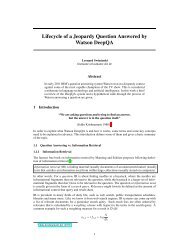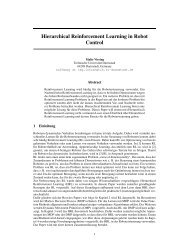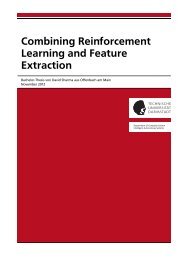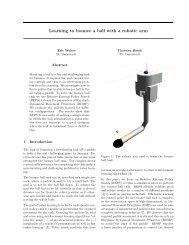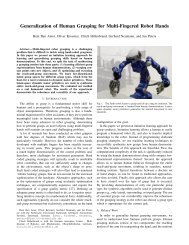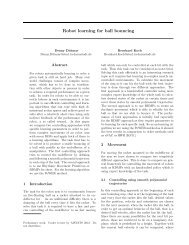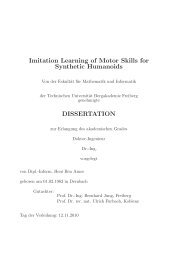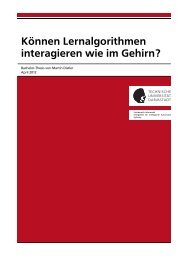Learning Motor Skills - Intelligent Autonomous Systems
Learning Motor Skills - Intelligent Autonomous Systems
Learning Motor Skills - Intelligent Autonomous Systems
You also want an ePaper? Increase the reach of your titles
YUMPU automatically turns print PDFs into web optimized ePapers that Google loves.
(a) The dart is<br />
placed on the<br />
launcher.<br />
(b) The arm<br />
moves back.<br />
(c) The arm<br />
moves forward<br />
on an arc.<br />
(d) The arm stops.<br />
(e) The dart is carried<br />
on by its<br />
momentum.<br />
(f) The dart hits<br />
the board.<br />
Figure 5.7: This figure shows a dart throw in a physically realistic simulation.<br />
(a) The dart is<br />
placed in the<br />
hand.<br />
(b) The arm<br />
moves back.<br />
(c) The arm<br />
moves forward<br />
on an arc.<br />
(d) The arm continues<br />
moving.<br />
(e) The dart is released<br />
and the<br />
arm follows<br />
through.<br />
(f) The arm stops<br />
and the dart<br />
hits the board.<br />
Figure 5.8: This figure shows a dart throw on the real JST-ICORP/SARCOS humanoid robot CBi.<br />
Compared to standard Gaussian process regression (GPR) in a supervised setting, CrKR can improve<br />
the policy over time according to a cost function and outperforms GPR in settings where different<br />
combinations of meta-parameters yield the same result. For details, see Figure 5.6.<br />
5.3.2 Robot Dart-Throwing Games<br />
Now, we turn towards the complete framework, i.e., we intend to learn the meta-parameters for motor<br />
primitives in discrete movements. We compare the Cost-regularized Kernel Regression (CrKR) algorithm<br />
to the reward-weighted regression (RWR). As a sufficiently complex scenario, we chose a robot dart<br />
throwing task inspired by [Lawrence et al., 2003]. However, we take a more complicated scenario and<br />
choose dart games such as Around the Clock [Masters Games Ltd., 2010] instead of simple throwing at a<br />
fixed location. Hence, it will have an additional parameter in the state depending on the location on the<br />
dartboard that should come next in the sequence. The acquisition of a basic motor primitive is achieved<br />
using previous work on imitation learning [Ijspeert et al., 2002b]. Only the meta-parameter function<br />
is learned using CrKR or RWR. For the learning process, the targets (which are part of the state) are<br />
uniformly distributed on the dartboard. For the evaluation the targets are placed in the center of the<br />
fields. The reward is calculated based on the impact position observed by a vision system in the real robot<br />
experiments or the simulated impact position.<br />
The dart is placed on a launcher attached to the end-effector and held there by stiction. We use the<br />
Barrett WAM robot arm in order to achieve the high accelerations needed to overcome the stiction. See<br />
Figure 5.7, for a complete throwing movement. The motor primitive is trained by imitation learning with<br />
kinesthetic teach-in. We use the Cartesian coordinates with respect to the center of the dart board as input<br />
states. In comparison with the benchmark example, we cannot directly influence the release velocity in<br />
this setup. Hence, we employ the parameter for the final position g, the time scale of the motor primitive<br />
τ and the angle around the vertical axis (i.e., the orientation towards the dart board to which the robot<br />
moves before throwing) as meta-parameters instead. The popular dart game Around the Clock requires<br />
80 5 Reinforcement <strong>Learning</strong> to Adjust Parametrized <strong>Motor</strong> Primitives to New Situations



